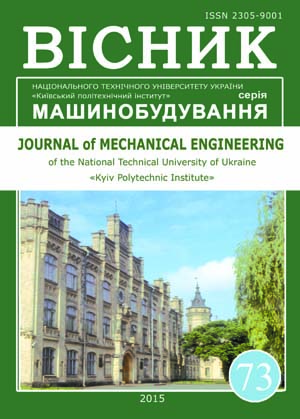VORTEX FLOW IN TWIST EXTRUSION
DOI:
https://doi.org/10.20535/2305-9001.2015.73.41660Keywords:
twist extrusion, simple shear, vortex flow, mixingAbstract
Twist extrusion (TE) is a metal forming technique for processing long metallic products by simple shear. This allows producing microstructures and textures of the billets radically different from those produced by conventional extrusion. The current study aims at investigation of vortex flow in TE that previously received little attention in the literature. Particularly, the mechanism of the vortex flow and its effects on the microstructure at different scales are elucidated.
For the experimental study of the kinematics of the flow of material workpieces of twist extrusion processed was used improved method of plasticity theory. According them the latter lies in the fact that to determine the stress-strain state of the workpiece is used kinematically admissible velocity fields with variable parameter determined by identifying the criterion of best fit lines of current theoretical and experimental.
Prospective applications of vortex flow in TE are also discussed.
References
1. Y. Beygelzimer, V. Varyukhin, S. Synkov and D. Orlov, Useful properties of twist extrusion, Mater. Sci. Eng. A, Vol. 503 (2009), pp. 14-17.
2. Y. Beygelzimer, Vortices and Mixing in Metals during Severe Plastic Deformation, Mater. Sci. Forum, Vol. 683 (2011), pp. 213-224.
3. P.W. Bridgman, Studies in large plastic flow and fracture, with special emphasis on the effects of hydrostatic pressure, McGraw-Hill, New York, 1952.
4. V.M. Segal, Severe plastic deformation: simple shear versus pure shear, Mater. Sci. Eng. A, Vol. 338 (2002), pp. 331-344.
5. A.P. Zhilyaev and T.G. Langdon Using high-pressure torsion for metal processing: Fundamentals and applications, Prog. Mater. Sci., Vol. 53 (2008), pp. 893-979.
6. R.Z. Valiev and T.G. Langdon, Principles of equal-channel angular pressing as a processing tool for grain refinement, Prog. Mater. Sci., Vol. 51 (2006), pp. 881-981.
7. V.M. Segal, US patent 7,096,705. (2006)
8. S. Mizunuma, Large straining behaviour and microstructure refinement of several metals by torsion extrusion process, Mater. Sci. Forum, Vol. 503-504 (2006), pp. 185-192.
9. N. Pardis and R. Ebrahimi, Deformation behavior in simple shear extrusion (SSE) as a new severe plastic deformation technique. 2009. Mater Sci Eng A Vol. 527 (2009) pp.355-360.
10. Y. Beygelzimer, D. Prilepo, R. Kulagin, V. Grishaev, O. Abramova, V. Varyukhin, and M. Kulakov, Planar Twist Extrusion versus Twist Extrusion, J. Mater. Process. Technol., Vol. 211 (2011), pp. 522-529.
11. C. Wang, F. Li, Q. Li, and L. Wang, Numerical and Experimental Studies of Pure CopperProcessed by a New Severe Plastic Deformation Method, Mater. Sci. Eng. A, Vol. 548 (2012), pp. 19-26.
12. Y. Estrin, A. Vinogradov, Extreme grain refinement by severe plastic deformation: A wealthof challenging science, Acta Materialia 61 (2013) p. 782–817.
13. Y. Beygelzimer, V. Varyukhin, R. Kulagin, O. Prokof’eva, A. Reshetov, Twist Extrusion – Technique for the Structure Formation, Proc. 10-th Conf. Techn. Plast. (ICTP2011) Ed. by G.Hirt and A.E.Tekkaya, Produced by Verlag Stahleisen GmbH, Düsseldorf, (2011), pp. 244-248.
14. Y. Beygelzimer, D. Orlov, and V. Varyukhin, Ultrafine Grained Materials II, The Minerals, Metals & Materials Society, Warrendale, PA (2002), pp. 297–304.
15. Y. Beygelzimer, N.Lavrinenko, Perfect plasticity of metals under simple shear as the result of percolation transition on grain boundaries, arXiv:1206.5055v1 [cond-mat.mtrl-sci].
16. R. Kulagin, M.I. Latypov, H.S. Kim, V. Varukhin,Y. Beygelzimer, Cross Flow during Twist Extrusion: Theory, Experiment and Application, Metallurgical and Materials Transactions A, Vol. 2 (2013), pp.1-11.
17. O. Bouaziz, H. S. Kim, Y. Estrin, Architecturing of Metal-Based Composites with Concurrent Nanostructuring: A New Paradigm of Materials Design Advanced Engineering Materials, DOI: 10.1002/adem.201200261.
18. D. Orlov, Y. Beygelzimer, S. Synkov, V. Varyukhin, N. Tsuji, and Z. Horita, Microstructure Evolution in Pure Al Processed with Twist Extrusion, Mater. Trans., Vol. 50 (2009), pp. 96–100.
19. J.M. Ottino, The Kinematics of Mixing: Stretching, Chaos and Transport, Cambridge University Press, Cambridge, UK, 1989.
20. P.R. Soni, Mechanical Alloying: Fundamentals and Applications, Cambridge International Science Publishing, Cambridge, UK, 2001.

